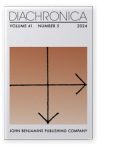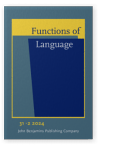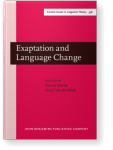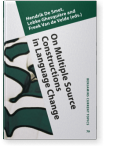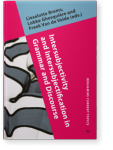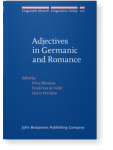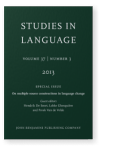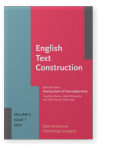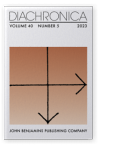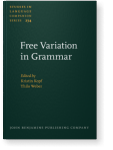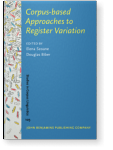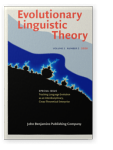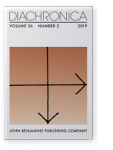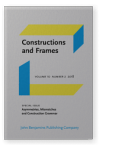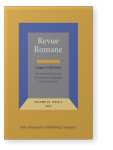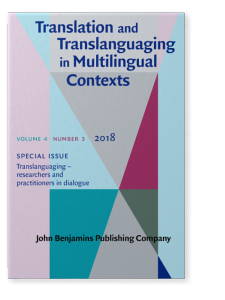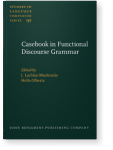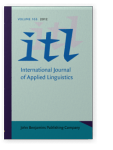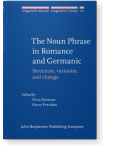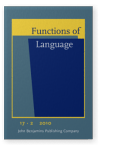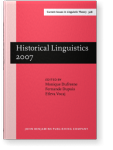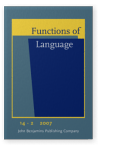Freek Van de Velde
List of John Benjamins publications for which Freek Van de Velde plays a role.
Journals
ISSN 0929-998X | E-ISSN 1569-9765
Exaptation and Language Change
Edited by Muriel Norde and Freek Van de Velde
[Current Issues in Linguistic Theory, 336] 2016. viii, 411 pp.
Subjects Historical linguistics | Theoretical linguistics
On Multiple Source Constructions in Language Change
Edited by Hendrik De Smet, Lobke Ghesquière and Freek Van de Velde
[Benjamins Current Topics, 79] 2015. v, 227 pp.
Subjects Functional linguistics | Historical linguistics | Syntax | Theoretical linguistics
Intersubjectivity and Intersubjectification in Grammar and Discourse: Theoretical and descriptive advances
Edited by Lieselotte Brems, Lobke Ghesquière and Freek Van de Velde
[Benjamins Current Topics, 65] 2014. vi, 161 pp.
Subjects Discourse studies | English linguistics | Germanic linguistics | Pragmatics | Syntax | Theoretical linguistics
Adjectives in Germanic and Romance
Edited by Petra Sleeman, Freek Van de Velde and Harry Perridon
[Linguistik Aktuell/Linguistics Today, 212] 2014. vii, 286 pp.
Subjects Generative linguistics | Germanic linguistics | Historical linguistics | Morphology | Romance linguistics | Syntax | Theoretical linguistics
On multiple source constructions in language change
Edited by Hendrik De Smet, Lobke Ghesquière and Freek Van de Velde
Special issue of Studies in Language 37:3 (2013) vi, 219 pp.
Subjects Functional linguistics | Theoretical linguistics | Typology
Intersections of Intersubjectivity
Edited by Lieselotte Brems, Lobke Ghesquière and Freek Van de Velde
Special issue of English Text Construction 5:1 (2012) v, 152 pp.
Subjects Applied linguistics | English linguistics | English literature & literary studies | Theoretical literature & literary studies
2024 Constraints and lexical conditioning in the dative alternation: A cross-linguistic analysis of English and Dutch Languages in Contrast: Online-First Articles | Article
This article presents a cross-linguistic variationist study of the dative alternations in English (I gave Tom a present vs. I gave a present to Tom) and Dutch (Ik gaf Tom een cadeau vs. Ik gaf een cadeau aan Tom). We use logistic mixed-effects regression and lasso regression to assess the… read more
2023 Diachrony and Diachronica: 40@40 Diachronica 40:5, pp. 666–682 | Editorial
2023 Chapter 8. Resemanticising ‘free’ variation: The case of V1 conditionals in Dutch Free Variation in Grammar: Empirical and theoretical approaches, Kopf, Kristin and Thilo Weber (eds.), pp. 229–257 | Chapter
Whether or not languages display ‘free’ variation is a moot point. In this article, we look at a near-synonymous pair in syntax, namely, V1 vs syndetic conditionals in Dutch, and argue that due to diachronic developments, Dutch has been in a situation for quite some time in which these two… read more
2021 Chapter 3. How register-specific is probabilistic grammatical knowledge? A programmatic sketch and a case study on the dative alternation with give Corpus-based Approaches to Register Variation, Seoane, Elena and Douglas Biber (eds.), pp. 51–84 | Chapter
While there is preliminary evidence about the importance of register in linguistic choice-making processes, systematic studies focusing on the interaction between register and language-internal constraints are lacking in variationist linguistics. This contribution sketches an ongoing project in… read more
2020 What are the determinants of survival curves of words? An evolutionary linguistics approach Tracking Language Evolution as an Interdisciplinary, Cross-Theoretical Enterprise, Gaeta, Livio (ed.), pp. 127–137 | Article
An evolutionary approach to historical linguistics can be enlightening when not only the mechanisms, but also the statistical methods are considered from neighboring disciplines. In this short paper, we apply survival analysis to investigate what factors determine the lifespan of words. Our case… read more
2019 Reassessing the evolution of West Germanic preterite inflection Diachronica 36:2, pp. 139–180 | Article
This article takes a quantitative approach to the long-term dynamics of the preterite inflection in West Germanic, with a special focus on Dutch. In a first step, we replicate two often-cited studies on English and German (Lieberman et al. 2007 and Carroll et al. 2012, respectively) by looking at… read more
2018 Constructional contamination in morphology and syntax: Four case studies Asymmetries, Mismatches and Construction Grammar, Koutsoukos, Nikos, Kristel Van Goethem and Hendrik De Smet (eds.), pp. 269–305 | Article
In every-day language use, two or more structurally unrelated constructions may occasionally give rise to strings that look very similar on the surface. As a result of this superficial resemblance, a subset of instances of one of these constructions may deviate in the probabilistic preference… read more
2017 La duplicación de clíticos en español como estrategia de marcación inversa Revue Romane 52:2, pp. 190–206 | Article
Clitic doubling is the phenomenon in which, in a clause, a NP or a stressed pronoun and a clitic pronoun refer to the same entity and have the same syntactic function. Previous studies on this phenomenon in Spanish observe that it takes place when the elements involved have features such as… read more
2016 Exaptation: Taking stock of a controversial notion in linguistics Exaptation and Language Change, Norde, Muriel and Freek Van de Velde (eds.), pp. 1–35 | Article
2015 Serving two masters: Form–function friction in syntactic amalgams On Multiple Source Constructions in Language Change, De Smet, Hendrik, Lobke Ghesquière and Freek Van de Velde (eds.), pp. 63–94 | Article
This paper examines two cases of so-called syntactic amalgams. In syntactic amalgams a particular string that is shared by two constructions is exploited to combine them, in such a way that one of the constructions functions as a modifier of the other. Typical examples are after God knows how many… read more
2015 On multiple source constructions in language change On Multiple Source Constructions in Language Change, De Smet, Hendrik, Lobke Ghesquière and Freek Van de Velde (eds.), pp. 1–17 | Article
2014 Intersections of intersubjectivity Intersubjectivity and Intersubjectification in Grammar and Discourse: Theoretical and descriptive advances, Brems, Lieselotte, Lobke Ghesquière and Freek Van de Velde (eds.), pp. 1–5 | Article
2014 Intersubjectivity and intersubjectification: Typology and operationalization Intersubjectivity and Intersubjectification in Grammar and Discourse: Theoretical and descriptive advances, Brems, Lieselotte, Lobke Ghesquière and Freek Van de Velde (eds.), pp. 129–153 | Article
In this paper we present our views on intersubjectivity and intersubjectification with reference to case studies on adjectives, hedges, tags, honorifics, etc. Building on Diessel’s notion of “joint attention” and Traugott’s approach to intersubjectivity, we propose a distinction between three types… read more
2014 The discourse motivation for split-ergative alignment in Dutch nominalisations (and elsewhere) The interaction between context and grammar in Functional Discourse Grammar, Alturo, Nuria, Evelien Keizer and Lluís Payrató (eds.), pp. 317–348 | Article
Dutch nominalisations of the type het eten van vlees (‘the eating of meat’) have ergative alignment. The alignment is functionally motivated, in that it is a natural consequence of the flow of discourse. The functional account that is put forward here draws on the notion of Preferred Argument… read more
2014 The resilient nature of adjectival inflection in Dutch Adjectives in Germanic and Romance, Sleeman, Petra, Freek Van de Velde and Harry Perridon (eds.), pp. 113–146 | Article
The rich Germanic adjectival inflection dramatically eroded in the history of Dutch as part of a general process of deflection. At present, Dutch is left with what appears to be a vestigial structure: an alternation between an inflected form in schwa and an uninflected form, the distribution of… read more
2014 The adjective in Germanic and Romance: Development, differences and similarities Adjectives in Germanic and Romance, Sleeman, Petra, Freek Van de Velde and Harry Perridon (eds.), pp. 1–32 | Article
In this introductory chapter the similarities and differences in the development and the current behavior of the adjective in Germanic and Romance, both within and between the language families, are discussed. A deeper analysis suggests that what seem to be differences may in fact be similarities… read more
2013 Serving two masters: Form–function friction in syntactic amalgams On multiple source constructions in language change, De Smet, Hendrik, Lobke Ghesquière and Freek Van de Velde (eds.), pp. 534–565 | Article
This paper examines two cases of so-called syntactic amalgams. In syntactic amalgams a particular string that is shared by two constructions is exploited to combine them, in such a way that one of the constructions functions as a modifier of the other. Typical examples are after God knows how many… read more
2013 External possessors and related constructions in Functional Discourse Grammar Casebook in Functional Discourse Grammar, Mackenzie, J. Lachlan and Hella Olbertz (eds.), pp. 155–188 | Article
This chapter is concerned with indirect object (or dative) external possessors and related constructions in Dutch. The related constructions are on the one hand other possessive constructions and on the other hand other indirect object constructions. The central question is what the semantic and… read more
2013 On multiple source constructions in language change On multiple source constructions in language change, De Smet, Hendrik, Lobke Ghesquière and Freek Van de Velde (eds.), pp. 473–489 | Article
2012 Intersections of intersubjectivity Intersections of Intersubjectivity, Brems, Lieselotte, Lobke Ghesquière and Freek Van de Velde (eds.), pp. 1–6 | Article
2012 Intersubjectivity and intersubjectification: Typology and operationalization Intersections of Intersubjectivity, Brems, Lieselotte, Lobke Ghesquière and Freek Van de Velde (eds.), pp. 128–152 | Article
In this paper we present our views on intersubjectivity and intersubjectification with reference to case studies on adjectives, hedges, tags, honorifics, etc. Building on Diessel’s notion of “joint attention” and Traugott’s approach to intersubjectivity, we propose a distinction between three… read more
2011 Anaphoric adjectives becoming determiners: A corpus-based account The Noun Phrase in Romance and Germanic: Structure, variation, and change, Sleeman, Petra and Harry Perridon (eds.), pp. 241–256 | Article
Standard accounts of determiners typically deal with the few well-known elements that fall under this category: articles, demonstratives, possessives and (some) quantifiers. It can be shown, however, that the determiner slot in Dutch can also be occupied by certain elements that do not regularly… read more
2009 The rise of peripheral modifiers in the noun phrase Historical Linguistics 2007: Selected papers from the 18th International Conference on Historical Linguistics, Montreal, 6–11 August 2007, Dufresne, Monique, Fernande Dupuis and Etleva Vocaj (eds.), pp. 175–184 | Article
As is not always recognised in the scholarly literature, the template of the noun phrase (np/dp) in Dutch and English contains a slot for peripheral modifiers, which precedes the determiner slot and hosts adverbial modifiers. In this article I argue that this slot is of recent date —it is an Early… read more
2007 Interpersonal modification in the English noun phrase Functions of Language 14:2, pp. 203–230 | Article
This article gives an overview of the various interpersonal modifiers in the English noun phrase, several of which seem to have been overlooked in formal as well as functional grammars. On the theoretical side, this article is concerned with how to bring the constructions at issue under a… read more
